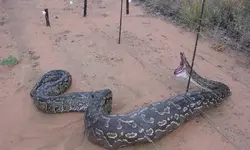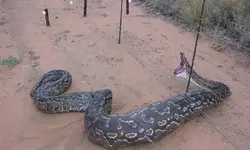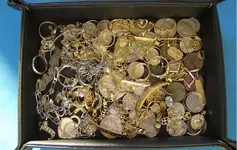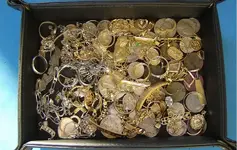VLF's WILL find targets under black sand.. as long as the concentration isn't too high. Highly mineralized ground does not automatically mean that the ground is carpeted with a layer of black sand.. just the overall mineralization. I've used PI's for quite a while and there are areas here where even a PI won't work. If you don't believe me, you can search for some of Steve Herschbach's observations about using a PI over basalt. The ground I generally hunt has an MXT VDI reading of 84-86, which denotes a highly mineralized ground matrix. Sticking a magnet into this ground, there will be up to 1/2" uf black sand covering it when it's withdrawn. There are often large streaks of black sand covering areas near water. Many of them I have successfully hunted over using the MXT (with DD coil and full gain/hypersat) and other VLF detectors. It's a common myth that PI's are unaffected by ground mineralization; taking a fixed GB PI with no adjustable autotune into many inland areas would disprove it. If you check out the ML gold hunting PI's, you can see that they have ground tracking and there's a good reason for this. Also, one of the reasons that a PI is generally less affected by ground mineralization is because of longer pulse delays. This reduces the sensitivity to smaller objects though. Check out the experiments done by Eric Foster and Reg Sniff utilizing PI's with pulse delays lower than 10 us. Ground signals tend to become a problem, as they are with VLF's. This is not to say that there aren't areas where I've had better success with a PI. While much of the ground here can be hunted with a VLF, the depth is lacking. Hunting at a favorite inland beach test area, I was getting 2-3 times the depth with a PI. Problem was, the hardpan was covered with nails. Luckily, I was using a Garrett Infinium (a very underrated detector) and was able to successfully use the dual tone (and adjustable pulse delay) to ID the majority of them. Pulled out plenty of old silver and a bit of gold. Right now, I'm waiting for the Pulse Devil to be (finally!!) released, which is a hybrid PI/VLF detector. Judging from what I've read, the PD should be able to work well in areas that pose problems for both VLF's and PI's.
One problem with a lot of VLF detectors, when faced with high concentrations of black sand, is that modern detectors often operate at both higher frequencies AND at high gain. This tends to swamp the receiver circuitry and lead to an overload response. Sometimes, even turning down the sensitivity doesn't help. I've been able to hunt areas with my old Golden Sabre that shut down 'better' detectors. There was an area in the Laguna's that basically shut down my buddy's GB1; I ran over it with my GS and picked out a couple of coins. A detector like the Ace 250 does pretty good in bad ground, being GB'd to ferrite at the factory. One way to minimize the ground response of both a preset GB and adjustable GB VLF detector is, if it has full range notching, to notch out the last segment. There's a phenomena often called 'wraparound' wherein a ground signal or tiny iron (usually) target hits in the highest conductivity segment, even when disc'ed out. Ther where areas I've recently hunted where the detector was constantly sounding off on a high tone with the reading pegged to the right. These were ground signals and, when notched out, didn't present a problem. I was able, after adjusting the disc., to hunt with the sensitivity set near maximum. ...Willy.







